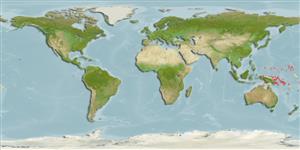>
Acanthuriformes (Surgeonfishes) >
Siganidae (Rabbitfishes)
Etymology: Siganus: Latin, siganus = a fish, rabbit fish; by the similarity of the nose (Ref. 45335).
Environment: milieu / climate zone / depth range / distribution range
Ecología
marino asociado a arrecife; rango de profundidad 1 - 15 m (Ref. 37816). Tropical; 15°N - 15°S, 135°E - 159°W
Western Pacific: Solomon Islands, Papua New Guinea, Pohnpei, Kosrae, and Guam.
Tamaño / Peso / Age
Maturity: Lm ? range ? - ? cm
Max length : 33.5 cm FL macho / no sexado; (Ref. 107958); common length : 25.0 cm TL macho / no sexado; (Ref. 9813); peso máximo publicado: 824.00 g (Ref. 107958)
Espinas dorsales (total): 13; Radios blandos dorsales (total): 10; Espinas anales 7; Radios blandos anales: 9; Vértebra: 23. Body is bronze, with bluish spots on the head and anterior portion of the body. These spots join in the posterior portion to form vermiculating patterns. Preopercular angle 98°-102°; strong scales covering cheeks with 9-11 rows deep below center of orbit; midline of thorax scaled, pelvic ridges without scales. Low rim of anterior nostril bearing a minute, pointed peak posteriorly. The spines are stout, blunt and venomous. S. randalli is similar to S. vermiculatus but is spotted on the head and front of the back (Ref. 37816).
Adults inhabit coral reef areas with sand and coral rubble, down to at least 15 m. Juveniles found in mangroves (Ref. 9710). Adults occur in schools of 10 to 20 or more and feed on algae growing on compacted pavement areas (Ref. 9813).
Life cycle and mating behavior
Madurez | Reproducción | Puesta | Huevos | Fecundidad | Larva
Woodland, D.J., 1990. Revision of the fish family Siganidae with descriptions of two new species and comments on distribution and biology. Indo-Pac. Fish. (19):136 p. (Ref. 1419)
IUCN Red List Status (Ref. 130435)
Threat to humans
Venomous
Human uses
Pesquerías: pesquerías de subsistencia; Acuicultura: experimental
Más información
ReferenciasAcuiculturaPerfil de acuiculturaRazasGenéticaElectrophoresesheritabilidadEnfermedadesProcesamientoNutrientsMass conversion
ColaboradoresImágenesStamps, Coins Misc.SonidosCiguateraVelocidadTipo de nataciónSuperficie branquialOtolitosCerebrosVisión
Herramientas
Special reports
Download XML
Fuentes de Internet
Estimates based on models
Preferred temperature (Ref.
123201): 28.7 - 29.5, mean 29.1 °C (based on 328 cells).
Phylogenetic diversity index (Ref.
82804): PD
50 = 0.5000 [Uniqueness, from 0.5 = low to 2.0 = high].
Bayesian length-weight: a=0.01479 (0.00801 - 0.02733), b=3.05 (2.89 - 3.21), in cm total length, based on LWR estimates for this species & Genus-body shape (Ref.
93245).
Nivel trófico (Ref.
69278): 2.0 ±0.00 se; based on food items.
Resiliencia (Ref.
120179): Alto, población duplicada en un tiempo mínimo inferior a 15 meses (Preliminary K or Fecundity.).
Fishing Vulnerability (Ref.
59153): Low to moderate vulnerability (27 of 100).
Nutrients (Ref.
124155): Calcium = 38.2 [18.7, 89.5] mg/100g; Iron = 0.675 [0.317, 1.554] mg/100g; Protein = 18.5 [17.0, 20.0] %; Omega3 = 0.094 [0.049, 0.188] g/100g; Selenium = 19.1 [7.5, 48.9] μg/100g; VitaminA = 32.3 [7.4, 131.7] μg/100g; Zinc = 1.39 [0.54, 2.95] mg/100g (wet weight);
